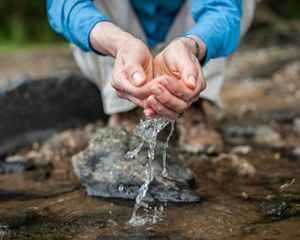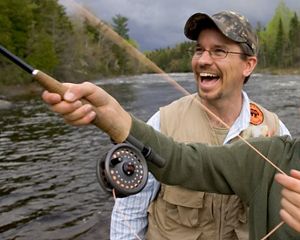There is a 1.6-mile trail loop on the hill above the river. It takes you through rich northern hardwoods, a young white pine and hemlock forest, an old sheep pasture and has views of the nearby hills. Please read our Preserve Visitation Guidelines.
What to See: Plants
Several natural communities at this preserve are directly adjacent to the White River. Floodplain forests are found on the lowest land near the river where soils are subject to annual flooding, but become relatively dry during the summer months. Clays and silts deposited by the flooding river are rich in organic matter and help these forests develop. Along this section of the White River, floodplain forests are found in small patches on either side of the river, and on small islands. They are dominated by ash-leaved maple, with occasional cottonwoods and white ash. The forest floor is often covered with chest-high ostrich ferns, as well as other herbs, ferns, and sedges. Floodplain forests are no longer common in Vermont because many of the state’s nutrient-rich floodplains have been converted for agricultural use.
Another rare riverside community found here is the calcareous riverside seep. This natural community occurs only in areas where calcium-rich groundwater seeps through exposed bedrock on river shores. The bedrock is maintained in an open condition by annual river flooding and ice scour. Larger woody plants cannot gain a foothold, but the nutrient-rich water seeping through bedrock crevices is an ideal habitat for many unusual grasses, forbs, sedges, and mosses.
Northern hardwood forest, a community dominated by American beech, sugar maple, and yellow birch, and pockets of rich northern hardwood forest grow on the upland areas of White River Ledges Natural Area. Rich northern hardwood forest communities occur where rich humus and the downslope movement of calcium-laden water provide vegetation with a steady supply of nutrients. As a result, plant diversity and overall growth is greater in this forest type than in regular northern hardwood forests, which lack the characteristically rich herb layer found in rich northern hardwood forests.
What to See: Animals
Rivers are like animal highways. They create corridors for aquatic and terrestrial animals. Migratory fish such as Atlantic salmon depend on undammed rivers like the White for their journey upstream to spawn. River otter, mink, raccoon and beaver use the river corridor for feeding habitat. Great blue herons, belted kingfishers, bank swallows, bald eagles and several species of ducks depend on the river’s resources for food and daily travel. White-tailed deer live in the uplands, and red newts are common in the forest. The White River’s many bedrock pools host crayfish and a variety of small fish.



